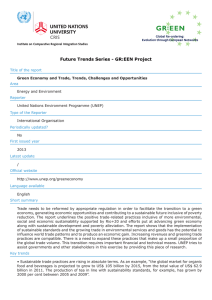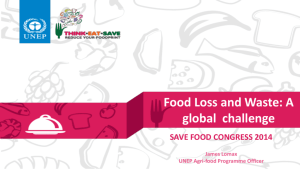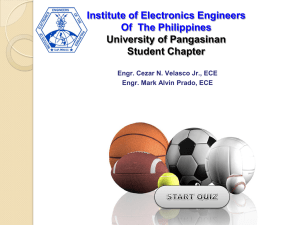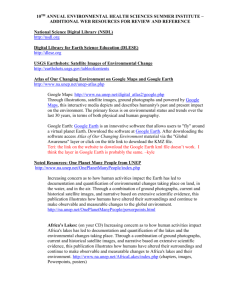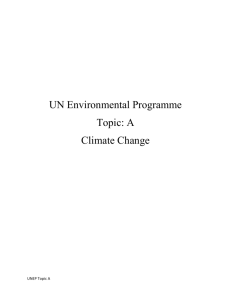By Ashbindu Singh Division of Early Warning & Assessment – North America
advertisement
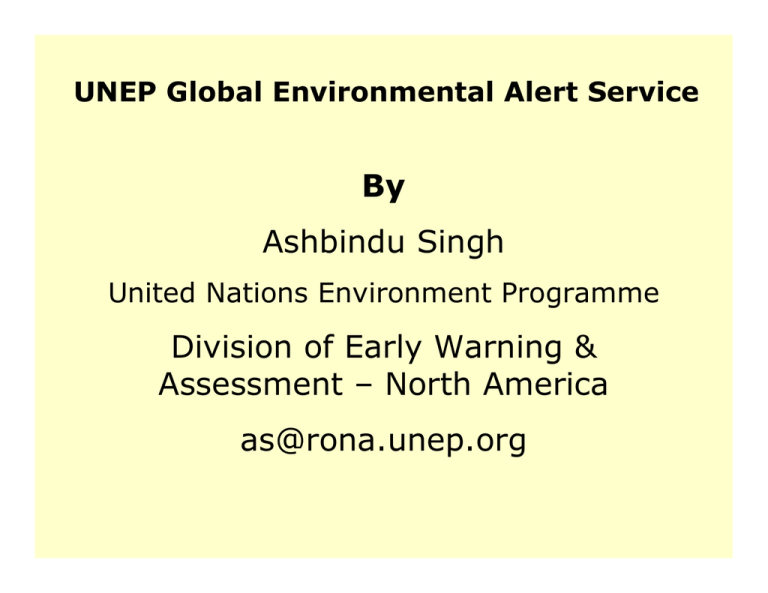
UNEP Global Environmental Alert Service By Ashbindu Singh United Nations Environment Programme Division of Early Warning & Assessment – North America as@rona.unep.org Vision Vision: Everyone in the world should have access to information about what is happening to his/her environment Mission: Providing scientific information for decision making Goal: Empowering people with engaging environmental information UNEP Global Environmental Alert Service (GEAS) • WHY? • WHAT? • HOW? Trend 1 - Responsibility and Accountability •Millennium Development Goals – reverse loss of environmental resources (by 2015) •Biodiversity Convention – reverse loss (by 2010) •Many more • Governments • Investors • Producers • Civil society Trend 2 – Information & Communication Technology • Satellite images better, cheaper, more abundant, more accessible • Hardware better, cheaper, smaller • Software better, cheaper, easier to use • Analysts better, more numerous • New users civil society activists !!! Globalization of locals: Connecting global to local (GLOCAL) ..Monitoring, Informing, Guiding.. Internet as the eighth wonder of the world (Public opinion survey Hindustantimes.com dated 11.8.2006 Technological drivers of change • Top four countries : number of people connected to Internet - USA, Japan, China and India; • Web 1.0: WWW, Yahoo, Google, Ebay etc.; • Web 2.0 : Social networking (Myspace.com, Facebook.com): Collaboration, knowledge sharing; • Internet 2 (10gb/sec); Dynamic data visualization and 3 D maaping, Videocasting, Podcasting; • Open software (Linux, Office tool online); $100 Laptop. The World is Flat: Globalization 3.0 (Thomas Friedman) • Is driven not by major corporations or giant trade organizations but by individuals: desktop freelancers and innovative startups all over the world; • Digital revolution that have made it possible to do business, or almost anything else, instantaneously with billions of other people across the planet; • "uploading," the direct-from-the-bottom creation of culture, knowledge, and innovation through blogging, podcasts, and open-source software Social media and new waves in web The new culture on the Web is all about consumer creation; it's composed of things like the nearly 30 million blogs out there. With a click of the mouse, anyone can be a journalist, a photographer. The audience -- that 1 billionplus throng linked by the Web--itself is creating a new type of social media. UNEP role Information and data aggregator Personalized streaming Collaborative publisher Social network Image sharing Mix & match and filtering CAP and RSS feed WHAT? UNEP’s Role • Grand integrator and communicator of scientifically credible data and information; • Connecting producer of information (i.e. GEOSS) to users; • Proactive in delivery of information to users via email, web services, SMS and other media; • Leverage upon partners assets and provide outlet to their products and services • Harness the power of Internet and other ICT tools e.g. 3 D visualization, mapping etc. WHY? Benefits to UNEP: • UNEP as a credible authoritative sources of environmental information; • Connecting stakeholders and catalyzing actions; • UNEP as a source of information to CNN, BBC etc.; • Implementation of the Bali Plan: Catalyze national actions for collection of data and provide public access to environmental information ; WHY? Benefits to UNEP: Enhancing UNEP’s capacity building efforts; • • Value added over Global Earth Observation System of Systems (GEOSS) products and services; • Enhanced accountability and transparency through ‘evidences’ and Visualization tools; HOW? Business Model: Business model between Nupedia (failed because of heavy peer review process) and Wikipedia (growing lack of credibility) HOW? Global Environmental Alert Service (GEAS) Sources GEAS Output Near-Real Time Information on Environmental Hazards (air pollution, Lake’s water level, etc.) Component 1 Near-Real Time Environmental Hazards Alerts Scientific Research Earth Observation Systems Scientific News Component 2 Change Analysis Environmental Hotspots Alerts Users UNEP and partners National Environment Ministries International Agencies Local knowledge Component 3 Environmental Science Alerts Scientific Findings Feedback Civil Society HOW? Global Environmental Alert Service (GEAS) HOW? Global Environmental Alert Service (GEAS) GEAS Component 1 Near-Real Time Environmental Hazards Alerts Sources Earth Observation Systems and models Ground Information Local Knowledge Analysis Output/ Communication Web Service with Real-time Screening Integration Maps: Google Map, Google Earth Synthesis Packaging Early Warning Alert: E-mail, SMS. HOW? Global Environmental Alert Service (GEAS) GEAS Component 1 Near-Real Time Environmental Hazards Alerts Output/ Communication Web Service with Real-time Maps: Google Map, Google Earth Content Extreme climate conditions, Aerosol, Lake’s level monitoring, Early Warning Alert: Natural Hazards E-mail, SMS. Wild Fires Air Pollution HOW? Global Environmental Alert Service (GEAS) GEAS Component 2 Environmental Hotspots Alerts Sources Earth Observation Systems and models Ground Information Local Knowledge Analysis Screening Integration Output/ Communication Environmental Change case studies Synthesis Packaging Google Earth Visualization UNEP Atlas of our Changing Environment Monitoring of environmental hot spots using before and after satellite images Atlas Design – Main Components Site Metadata Visiting Scientist Site Imagery Site Metadata INTRANET UNEP Digital Atlas Database Google Image Server UNEP WWW Server INTERNET Site Imagery UNEP on Google Earth Search Panel Places Panel Layers Panel Featured Content HOW? Global Environmental Alert Service (GEAS) GEAS Component 3 Environmental Science Alerts Sources Analysis Output/ Communication Screening Findings of Scientific Research Integration Synthesis Packaging • Science and policy briefs • Journal access • Research online • Educational resources/ PPT • Solutions case studies Malaria Early Warning for Sub Saharan Africa Recently, a group of scientists from the Center for MediumRange Weather Forecasts in Reading, UK, developed a method for predicting malaria impact several months in advance. Malaria represents the most important parasitic infection in people causing more than 1 million deaths each year, mostly in Sub-Saharan ……. Unfortunately more often malaria treatments are not easily accessible and effective in Africa, especially to ones References Palmer T. N., Alessandri A., Andersen U., … Environmental Science on the Internet Ask UNEP? - What is environmental situation in my background? (Type the address and get location of toxic waste site, level of air pollution etc.) - What are environmental consequences of my choices? ( connecting local to global) HOW? The use of Standard Formats • The advantage of standard format alerts is their compatibility with all information systems, warning systems, media, and most importantly, with new technologies such as web services. • A partnership with Google and the news media is being explored HOW? The use of Standard Formats • CAP: Common Alerting Protocol A standard format designed for exchange of alert messages: – about any kind of threat situation Weather, Fires, Air Quality Warnings, Earthquakes, Volcanoes, Landslides, Disease Outbreaks, Beach Closings, Transportation Problems, Power Outages, ... – over any and all media television, radio, telephone, fax, highway signs, e-mail, Web sites, RSS "Blogs", ... – to the public or to specific people • RSS: Really Simple Syndication A standard format designed for news information exchange: – through aggregators of RSS feeds HOW? GEAS – Near Real Time Component GEAS Component 1 Automatic Selection Sources Parser Alert Database Automatic Selection Automatic Selection Formatter Formatter CAP Google Earth KML Google Maps Email Alert System Visualization Email Alert SMS MEDIA Email Database HOW? GEAS – Near Real Time Component Implementation and Challenges • Identification of credible sources supporting standard format- Few sources use standard formats • Automatic streaming of information from sources- Script tailored to source • Database of Alerts- Design and Management • Packaging of information- Develop CAP • Database of Users- Subscription and Outreach • Visualization of Alerts- Google partnership • Email, SMS to users- Google partnership GEAS – Near Real Time Component: Demo HOW? GEAS – Near Real Time Component Demo http://www.na.unep.net/geas/index.php


